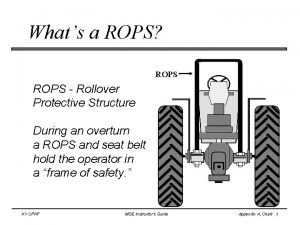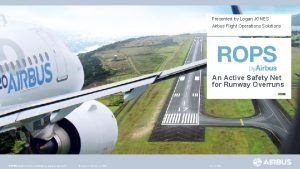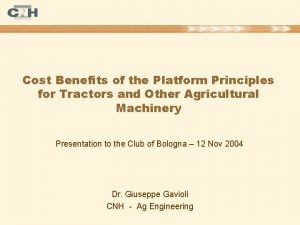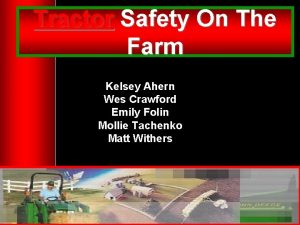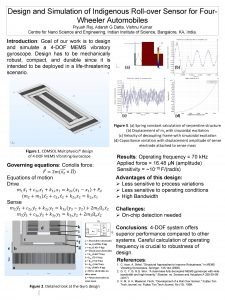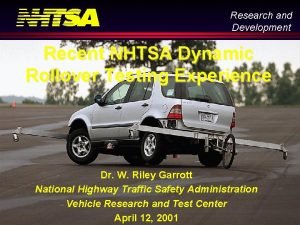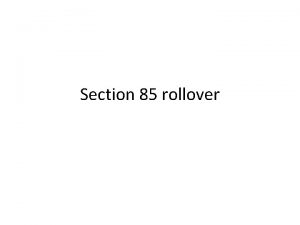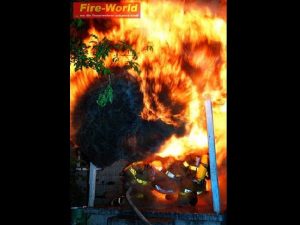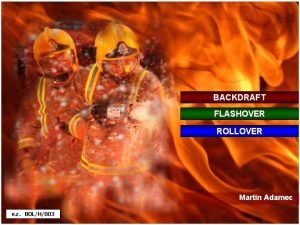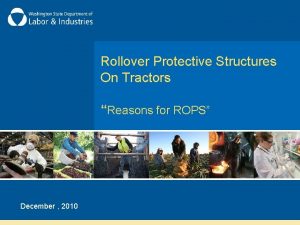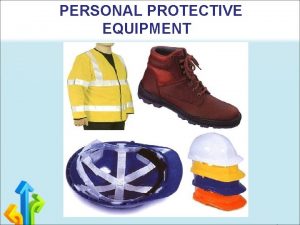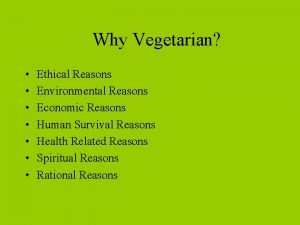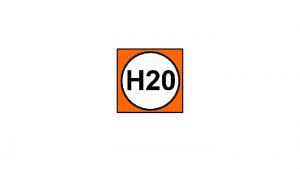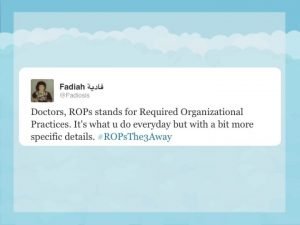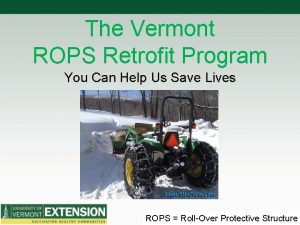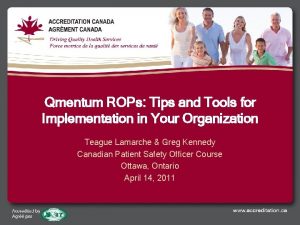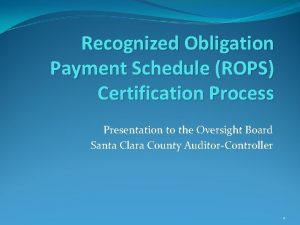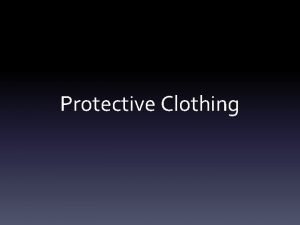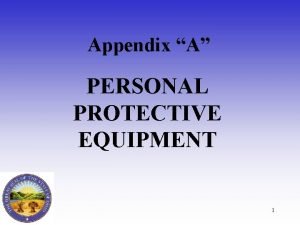Rollover Protective Structures On Tractors Reasons for ROPS

























- Slides: 25

Rollover Protective Structures On Tractors “Reasons for ROPS” November, 2021

What You Will Learn Rollover Protective Structures are called ROPS • What are ROPS and What is a Protective Zone? • Why do tractors need ROPS? • How do ROPS work? • What are some rollover prevention strategies? • Where can I buy ROPS? Washington State Department of Labor & Industries 2

What Are ROPS? ROPS are: “Rollover Protective Structures”. They are a bar, frame or cab that creates a protective zone around the operator. They virtually eliminate tractor rollover fatalities when used properly. These are ROPS Washington State Department of Labor & Industries 3

What is a Protective Zone? Protective Zone: The space surrounding an operator’s body. ROPS and a seatbelt keeps the operator within this safe space in the event of a rollover. This is the Protective Zone Washington State Department of Labor & Industries 4

WARNING !!! If your tractor does not have ROPS: DO Consult an authorized dealership or the manufacturer to purchase and install ROPS. OR Make and install ROPS yourself. (But they must meet the requirements for ROPS for wheel-type tractors in CFR 1928. 51, and track-type tractors must meet the requirements of SAE J 334 a (July 1970) and portions of SAE J 167 (1971) Standards. ) Washington State Department of Labor & Industries 5

Why Do Tractors Need ROPS? According to the University of Iowa Agricultural Center: – Tractors that roll over without ROPS = 75% chance of operator death – With ROPS and seatbelts = 95% chance of walking away from the accident – In 76 fatal rollover cases studied = All 76 victims were operating tractor without ROPS and seatbelts. Washington State Department of Labor & Industries 6

Why Do Tractors Need ROPS? Because tractors are susceptible to roll over accidents Tractor roll over fatalities in Washington State: 2010 – 5 (A bad year) 2009 - 2006 - none 2005 – 2 2004 – 2 2003 – 1 Washington State Department of Labor & Industries 7

Basic Cause of Rollovers happen when the center of gravity passes over the baseline of stability, either to the side or the rear of the machine. The center of gravity must be kept within the baseline of stability to keep the tractor right side up. Washington State Department of Labor & Industries 8

How Do ROPS Work? With ROPS, the tractor often rolls just 90 degrees, keeping the operator in a safe zone. ROPS, and a seatbelt prevents the operator from being thrown off the tractor and being crushed by the tractor, or being thrown into the ground or into surrounding objects. Washington State Department of Labor & Industries 9

How Do ROPS Work? You must wear the seatbelt or ROPS are worthless. Tighten the seatbelt sufficiently, so you stay in the protective zone. Wear the seatbelt always, even on flat ground. ROPS Washington State Department of Labor & Industries Seatbelt 10

How Do ROPS Work? The next two slides show a tractor with ROPS in a side rollover. • Side rollovers account for about 75% of all rollovers. • Notice how an operator could survive the roll by staying within the safe area. Washington State Department of Labor & Industries 11

How Do ROPS Work? Tractor is heading towards depressions in the side of the hill. Front wheels catch the depressions and start the roll

How Do ROPS Work? Definitely past the point of no return. With ROPS and seatbelt, operator has an excellent chance of surviving a side rollover.

How Side Rollovers Happen When the tractor is driven on a hillside that is too steep. When a tractor with an attachment is elevated too high for a given load, driven on a hillside that is too steep, or is turned at excessive speed. When the tractor is driven too close to the edge of the road, a ditch, or other steep slope. Washington State Department of Labor & Industries 14

To Belt or Not? Just in case you think you might consider skipping using the seatbelt, look at the next slide and see what can happen. Washington State Department of Labor & Industries 15

To Belt or Not? Operator Even though this tractor had ROPS, the seatbelt was not used, causing the operator to be ejected from the protective zone.

What about a rear rollover? With ROPS and seatbelt, operator has an excellent chance of being contained in the protective zone and surviving a rear rollover. The ROPS may also prevent the tractor from completely rolling over backward Washington State Department of Labor & Industries 17

How Rear Rollovers Happen • Tractors will easily tip to the rear when the rear wheels cannot rotate enough to move the tractor forward. • As the tractor front rises, momentum and engine power work together to keep the tractor body lifting and rotating. • The process can take less than ¾ of a second. Washington State Department of Labor & Industries 18

How Rear Rollovers Happen (Cont. ) Five situations causing rear rollovers: § Stuck in mud or snow, prevents rear wheels from rotating. § Rear wheels cannot turn because chains, boards, or other materials are used to improve traction and actually prevent the wheels from turning. § Tractor is climbing a hill that is too steep. The steeper the hill, the greater the risk. § With the transmission in a lower gear and the engine running at high speed, the clutch is released too quickly. § A load is hitched above the drawbar. Washington State Department of Labor & Industries 19

Prevention Strategies To Prevent Side Rollovers: § Set wheels at widest possible setting for the job. § Lock brake pedals for road travel. § Reduce speed while turning, crossing slopes, and on rough, slick, or muddy terrain. § Watch where you are going, look out for bumps, stumps, holes, etc. Washington State Department of Labor & Industries 20

Prevention Strategies To Prevent Side Rollovers: (Con’t. ) § if possible. § Keep side mounted equipment on uphill side of slope. § Pull heavy loads at slow speeds. § Avoid driving too close to ditches, stream banks, and canals. Washington State Department of Labor & Industries 21

Prevention Strategies To Prevent Rear Rollovers: (Con’t. ) § Hitch towed loads to the drawbar only. § Use counter weight to increase stability. § Start forward motion slowly and change speed gradually. § Back up steep slopes. Washington State Department of Labor & Industries 22

Prevention Strategies - Training § Of the many tractor injuries and deaths that happen, few are caused by machinery failure. § Most are caused, directly or indirectly, by carelessness and hurry. § Every operator should be trained in safe operating procedures. See the presentation: Ten Commandments of Tractor Safety Washington State Department of Labor & Industries 23

Prevention Strategies - Training The operator must be aware of the ever-changing environment and be able to react accordingly. For examples, operators must know: • When a hillside too steep for safe travel • When an elevated load too high for a given speed See: : Training Requirements for ROPS Washington State Department of Labor & Industries 24

Where Do I Buy ROPS? If your tractor does not have a ROPS: • Check with your local dealership or contact the tractor manufacturer. • Many manufacturers will sell ROPS “at cost. ” • You are allowed to construct home-made ROPS but they must meet the requirements for ROPS for wheel-type tractors in CFR 1928. 51, and track-type tractors must meet the requirements of SAE J 334 a (July 1970) and portions of SAE J 167 (1971) Standards. Washington State Department of Labor & Industries 25
 Rops safety
Rops safety Airbus rops
Airbus rops Tractors
Tractors Ahern tractor
Ahern tractor Gnu 700 tractor
Gnu 700 tractor Rollover sensor
Rollover sensor Rollover phenomenon in acoustic neuroma
Rollover phenomenon in acoustic neuroma Dynamic rollover
Dynamic rollover Section 85 rollover example
Section 85 rollover example S85 rollover
S85 rollover Rauchdurchzündung
Rauchdurchzündung Closing entries sole proprietorship
Closing entries sole proprietorship Ksk rollover
Ksk rollover Flameover vs flashover
Flameover vs flashover Give other examples of homologous structures
Give other examples of homologous structures Plats för toran ark
Plats för toran ark Expektans eller exspektans
Expektans eller exspektans Tillitsbaserad ledning
Tillitsbaserad ledning Ro i rom pax
Ro i rom pax Boverket ka
Boverket ka Mästar lärling modellen
Mästar lärling modellen Varför kallas perioden 1918-1939 för mellankrigstiden
Varför kallas perioden 1918-1939 för mellankrigstiden Vad är verksamhetsanalys
Vad är verksamhetsanalys Borstål, egenskaper
Borstål, egenskaper Vishnuiter
Vishnuiter Cks
Cks
